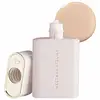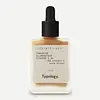Westman Atelier Vital Skincare Complexion Drops Versus Typology Tinted Serum Vitamin C, Squalane & Aloe Vera
What's inside
What's inside
 Key Ingredients
Key Ingredients

 Benefits
Benefits

 Concerns
Concerns

 Ingredients Side-by-side
Ingredients Side-by-side

Squalane
EmollientWater
Skin ConditioningPersea Gratissima Oil
Skin ConditioningPunica Granatum Seed Oil
EmollientMica
Cosmetic ColorantPentylene Glycol
Skin ConditioningCamellia Japonica Seed Oil
EmollientPolyglyceryl-3 Polyricinoleate
EmulsifyingSorbitan Isostearate
EmulsifyingPropanediol
SolventHelianthus Annuus Seed Oil
EmollientPanax Ginseng Root Extract
EmollientZingiber Officinale Root Extract
MaskingOryza Sativa Extract
AbsorbentOryza Sativa Germ Extract
EmollientBisabolol
MaskingDisteardimonium Hectorite
StabilisingGlycine Soja Oil
EmollientGossypium Hirsutum Seed Oil
Skin ConditioningPrunus Amygdalus Dulcis Oil
Skin ConditioningTriticum Vulgare Germ Oil
EmollientZea Mays Germ Oil
Emollient4-T-Butylcyclohexanol
MaskingGlyceryl Caprylate/Caprate
EmollientAluminum Hydroxide
EmollientPolyglyceryl-3 Diisostearate
EmulsifyingDimer Dilinoleyl Dimer Dilinoleate
EmollientTin Oxide
AbrasiveSodium Lauroyl Glutamate
Lysine
Skin ConditioningMagnesium Chloride
Tocopherol
AntioxidantCI 77891
Cosmetic ColorantIron Oxides
CI 77491
Cosmetic ColorantCI 77492
Cosmetic ColorantCI 77499
Cosmetic ColorantSqualane, Water, Persea Gratissima Oil, Punica Granatum Seed Oil, Mica, Pentylene Glycol, Camellia Japonica Seed Oil, Polyglyceryl-3 Polyricinoleate, Sorbitan Isostearate, Propanediol, Helianthus Annuus Seed Oil, Panax Ginseng Root Extract, Zingiber Officinale Root Extract, Oryza Sativa Extract, Oryza Sativa Germ Extract, Bisabolol, Disteardimonium Hectorite, Glycine Soja Oil, Gossypium Hirsutum Seed Oil, Prunus Amygdalus Dulcis Oil, Triticum Vulgare Germ Oil, Zea Mays Germ Oil, 4-T-Butylcyclohexanol, Glyceryl Caprylate/Caprate, Aluminum Hydroxide, Polyglyceryl-3 Diisostearate, Dimer Dilinoleyl Dimer Dilinoleate, Tin Oxide, Sodium Lauroyl Glutamate, Lysine, Magnesium Chloride, Tocopherol, CI 77891, Iron Oxides, CI 77491, CI 77492, CI 77499
Water
Skin ConditioningIsoamyl Laurate
EmollientC9-12 Alkane
SolventSqualane
EmollientPolyglyceryl-3 Diisostearate
EmulsifyingPropanediol
SolventSilica
AbrasivePolyglyceryl-6 Polyricinoleate
EmulsifyingGlycerin
HumectantMagnesium Sulfate
Ascorbyl Tetraisopalmitate
AntioxidantPolyglyceryl-2 Isostearate
EmulsifyingCoco-Caprylate/Caprate
EmollientDisteardimonium Hectorite
StabilisingHydroxyethylcellulose
Emulsion StabilisingSodium Benzoate
MaskingDisodium Stearoyl Glutamate
CleansingPotassium Sorbate
PreservativeAloe Barbadensis Leaf Juice
Skin ConditioningAluminum Hydroxide
EmollientSodium Nitrate
SoothingCI 77891
Cosmetic ColorantCI 77492
Cosmetic ColorantCI 77491
Cosmetic ColorantCI 77499
Cosmetic ColorantWater, Isoamyl Laurate, C9-12 Alkane, Squalane, Polyglyceryl-3 Diisostearate, Propanediol, Silica, Polyglyceryl-6 Polyricinoleate, Glycerin, Magnesium Sulfate, Ascorbyl Tetraisopalmitate, Polyglyceryl-2 Isostearate, Coco-Caprylate/Caprate, Disteardimonium Hectorite, Hydroxyethylcellulose, Sodium Benzoate, Disodium Stearoyl Glutamate, Potassium Sorbate, Aloe Barbadensis Leaf Juice, Aluminum Hydroxide, Sodium Nitrate, CI 77891, CI 77492, CI 77491, CI 77499
 Reviews
Reviews

Alternatives
Ingredients Explained
These ingredients are found in both products.
Ingredients higher up in an ingredient list are typically present in a larger amount.
Aluminum Hydroxide is a form of aluminum. It can be naturally found in nature as the mineral gibbsite. In cosmetics, Aluminum Hydroxide is used as a colorant, pH adjuster, and absorbent.
As a colorant, Aluminum Hydroxide may add opacity, or reduce the transparency. Aluminum hydroxide is contains both basic and acidic properties.
According to manufacturers, this ingredient is an emollient and humectant. This means it helps hydrate the skin.
In medicine, this ingredient is used to help relieve heartburn and help heal ulcers.
There is currently no credible scientific evidence linking aluminum hydroxide in cosmetics to increased cancer risk.
Major health organizations allow the use of aluminum hydroxide in personal care products and have not flagged it as a carcinogenic risk at typical usage levels.
Learn more about Aluminum HydroxideCi 77491 is also hydrated iron III oxide. It's sole purpose is to give a red/pink hue to products.
Iron III oxides are classified as inorganic chemicals for coloring.
Synthetically created Ci 77491 is considered safer than those naturally found. This is because the synthetically created version may contain less impurities. Iron oxides are generally non-toxic and non-allergenic.
Learn more about CI 77491Ci 77492 is also hydrated iron III oxide. It's sole purpose is to give a yellow hue to products.
Iron III oxides are classified as inorganic chemicals for coloring.
Synthetically created Ci 77492 is considered safer than those naturally found. This is because the synthetically created version may contain less impurities. Iron oxides are generally non-toxic and non-allergenic.
Learn more about CI 77492Ci 77499 is also hydrated iron III oxide. It is created from mixing red and black iron oxides. This helps give shades of darkness to a product.
Iron III oxides are classified as inorganic chemicals for coloring.
Ci 77891 is a white pigment from Titanium dioxide. It is naturally found in minerals such as rutile and ilmenite.
It's main function is to add a white color to cosmetics. It can also be mixed with other colors to create different shades.
Ci 77891 is commonly found in sunscreens due to its ability to block UV rays.
Learn more about CI 77891Disteardimonium Hectorite comes from the clay mineral named hectorite. It is used to add thickness to a product.
It can also help stabilize a product by helping to disperse other ingredients.
Hectorite is a rare, white clay mineral.
Learn more about Disteardimonium HectoritePolyglyceryl-3 Diisostearate is an emulsifer and emollient. It comes from Isostearic Acid and Polyglycerin-3.
As an emulsifier, it helps stabilize products by preventing oils and water from separating.
This ingredient may not be Malassezia folliculitis, or fungal acne safe.
Learn more about Polyglyceryl-3 DiisostearatePropanediol is an all-star ingredient. It softens, hydrates, and smooths the skin.
It’s often used to:
Propanediol is not likely to cause sensitivity and considered safe to use. It is derived from corn or petroleum with a clear color and no scent.
Learn more about PropanediolSqualane is an emollient that helps the skin hold onto moisture. It's an oily liquid that occurs naturally in certain types of fish and plant oils.
Because squalane boosts hydration in the skin, it also comes with plenty of benefits: it is an antioxidant and can help fight free radicals and skin damage. Squalane is also found to have a detoxifying effect when applied.
Squalane comes from squalene, which occurs naturally within the sebum of our skin. It is one of the oils our skin produces to keep itself hydrated. Squalane is the hydrogenated version of squalene and has a longer shelf life.
Research shows that squalane is non-irritating (even at 100% concentration).
In general, it's a fantastic ingredient. It does a great job at hydrating the skin, and it's suitable for those with sensitive skin.
The source of squalane may impact malassezia / fungal acne. This is because olive oil derived squalane can contain impurities such as fatty acids and plant waxes. Sugarcane derived squalane is recommended for anyone with malassezia concerns.
Is squalane vegan?
This depends on the source. Squalane can be derived from both plants and animals. Most squalane used in skincare comes from plants.
Please note: the source of squalane is only known if disclosed by the brand. We recommend reaching out to the brand if you have any questions about their squalane.
Read more about squalene with an "e".
Is squalane an oil?
Squalane is often called an oil, but it’s technically not; it’s a hydrocarbon, meaning it’s only made of carbon and hydrogen, unlike true oils which are triglycerides made of fatty acids and glycerol.
The term “oil-free” isn’t regulated, so companies can define it however they want. Some exclude all oils, while others just avoid mineral oil or comedogenic oils.
While some people avoid oils thinking they cause breakouts, the right kind of oil (or oil-like ingredient like squalane) can actually help balance and hydrate your skin. It’s worth testing out simple oils or squalane to see what works best for your skin.
Learn more about SqualaneWater. It's the most common cosmetic ingredient of all. You'll usually see it at the top of ingredient lists, meaning that it makes up the largest part of the product.
So why is it so popular? Water most often acts as a solvent - this means that it helps dissolve other ingredients into the formulation.
You'll also recognize water as that liquid we all need to stay alive. If you see this, drink a glass of water. Stay hydrated!
Learn more about Water